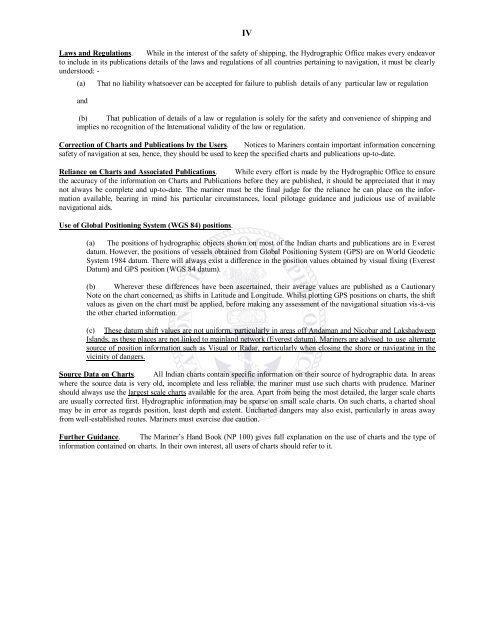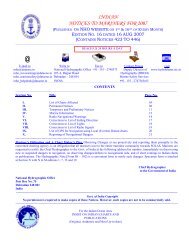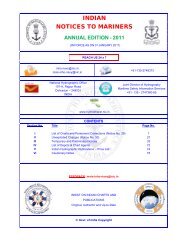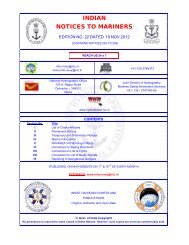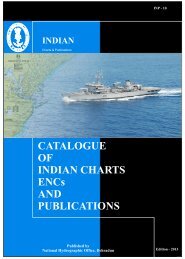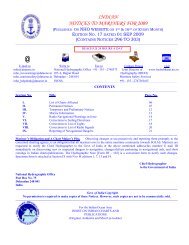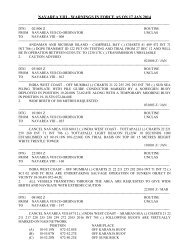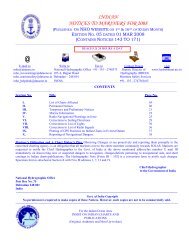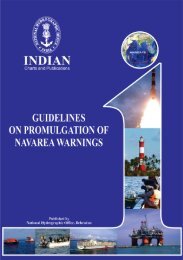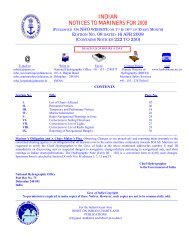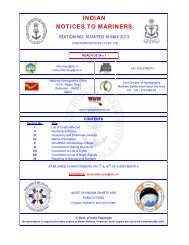Edition 02 of 2012. - Indian Naval Hydrographic Department
Edition 02 of 2012. - Indian Naval Hydrographic Department
Edition 02 of 2012. - Indian Naval Hydrographic Department
You also want an ePaper? Increase the reach of your titles
YUMPU automatically turns print PDFs into web optimized ePapers that Google loves.
IV<br />
Laws and Regulations. While in the interest <strong>of</strong> the safety <strong>of</strong> shipping, the <strong>Hydrographic</strong> Office makes every endeavor<br />
to include in its publications details <strong>of</strong> the laws and regulations <strong>of</strong> all countries pertaining to navigation, it must be clearly<br />
understood: -<br />
(a) That no liability whatsoever can be accepted for failure to publish details <strong>of</strong> any particular law or regulation<br />
and<br />
(b) That publication <strong>of</strong> details <strong>of</strong> a law or regulation is solely for the safety and convenience <strong>of</strong> shipping and<br />
implies no recognition <strong>of</strong> the International validity <strong>of</strong> the law or regulation.<br />
Correction <strong>of</strong> Charts and Publications by the Users. Notices to Mariners contain important information concerning<br />
safety <strong>of</strong> navigation at sea, hence, they should be used to keep the specified charts and publications up-to-date.<br />
Reliance on Charts and Associated Publications. While every effort is made by the <strong>Hydrographic</strong> Office to ensure<br />
the accuracy <strong>of</strong> the information on Charts and Publications before they are published, it should be appreciated that it may<br />
not always be complete and up-to-date. The mariner must be the final judge for the reliance he can place on the information<br />
available, bearing in mind his particular circumstances, local pilotage guidance and judicious use <strong>of</strong> available<br />
navigational aids.<br />
Use <strong>of</strong> Global Positioning System (WGS 84) positions.<br />
(a) The positions <strong>of</strong> hydrographic objects shown on most <strong>of</strong> the <strong>Indian</strong> charts and publications are in Everest<br />
datum. However, the positions <strong>of</strong> vessels obtained from Global Positioning System (GPS) are on World Geodetic<br />
System 1984 datum. There will always exist a difference in the position values obtained by visual fixing (Everest<br />
Datum) and GPS position (WGS 84 datum).<br />
(b) Wherever these differences have been ascertained, their average values are published as a Cautionary<br />
Note on the chart concerned, as shifts in Latitude and Longitude. Whilst plotting GPS positions on charts, the shift<br />
values as given on the chart must be applied, before making any assessment <strong>of</strong> the navigational situation vis-à-vis<br />
the other charted information.<br />
(c) These datum shift values are not uniform, particularly in areas <strong>of</strong>f Andaman and Nicobar and Lakshadweep<br />
Islands, as these places are not linked to mainland network (Everest datum). Mariners are advised to use alternate<br />
source <strong>of</strong> position information such as Visual or Radar, particularly when closing the shore or navigating in the<br />
vicinity <strong>of</strong> dangers.<br />
Source Data on Charts. All <strong>Indian</strong> charts contain specific information on their source <strong>of</strong> hydrographic data. In areas<br />
where the source data is very old, incomplete and less reliable, the mariner must use such charts with prudence. Mariner<br />
should always use the largest scale charts available for the area. Apart from being the most detailed, the larger scale charts<br />
are usually corrected first. <strong>Hydrographic</strong> information may be sparse on small scale charts. On such charts, a charted shoal<br />
may be in error as regards position, least depth and extent. Uncharted dangers may also exist, particularly in areas away<br />
from well-established routes. Mariners must exercise due caution.<br />
Further Guidance. The Mariner’s Hand Book (NP 100) gives full explanation on the use <strong>of</strong> charts and the type <strong>of</strong><br />
information contained on charts. In their own interest, all users <strong>of</strong> charts should refer to it.


